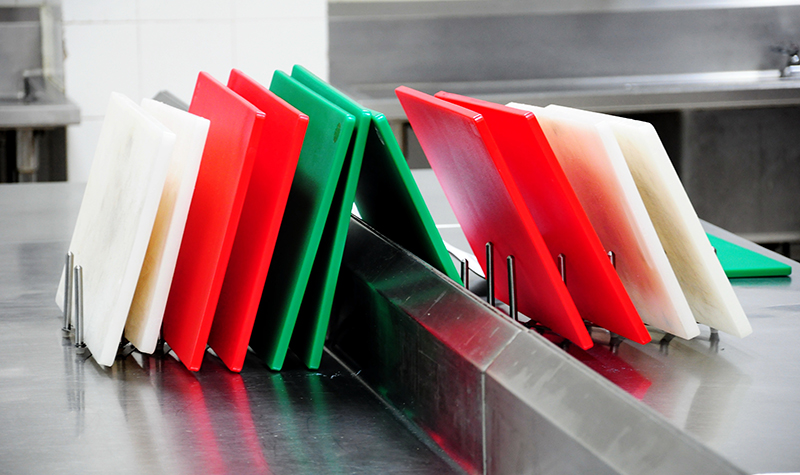As the world responds to the coronavirus pandemic—and foodservice providers adjust to carry out- and delivery-only operations—it’s worth noting that, per the U.S. Food & Drug Administration (FDA), there’s no evidence of food or food packaging being associated with the transmission of COVID-19.1 However, now more than ever, it’s imperative that foodservice operators take additional steps to ensure their guests feel safe when ordering and consuming their food, whether by delivery or carryout.
More than 60 percent of all foodborne disease outbreaks in the United States originate in foodservice establishments, according to the Centers for Disease Control and Prevention.2 One of the leading causes of foodborne disease outbreaks is cross-contamination. Cross-contamination occurs when disease-causing pathogens—e.g., bacteria and viruses—are transferred from one food to another.3 This typically happens in one of two ways: when the same equipment, such as cutting boards or utensils, is used to prepare both cooked and raw meats, or through poor hygiene practices among food handlers.3
Cross-contamination can happen at various stages and locations in the foodservice environment, including during storage, the food prep process, or final preparation and service.3
The good news: Implementing food safety management systems has significantly reduced the number of food safety violations in American restaurants and cafeterias, according to the FDA.2 With that in mind, here are three things you should be doing to prevent cross-contamination in your own establishment:
- Train employees on effective cleaning techniques.
Because cross-contamination is a result of human error, the No. 1 way to prevent it is with robust food safety training. Employees should know how to handle raw and cooked foods at every stage of the food preparation process, in addition to maintaining the highest levels of personal hygiene. First and foremost, they should be trained to wash their hands frequently, particularly after using the restroom and when handling raw seafood, meat or poultry.3
Employees also should be taught to use disposable gloves and to change them every time they switch to handling a new food product. In addition, staff should refrain from using aprons or cleaning towels to wipe their hands before and during food prep tasks.3
For added peace of mind, operators might consider asking food handlers to obtain certifications in safe food handling. The National Restaurant Association’s ServSafe® program offers food safety training and education led by experienced industry experts. The ServSafe Food Handler program teaches basic food safety practices for preparing and serving food, while the ServSafe Food Manager program delves further into the origins of foodborne illnesses, how to prevent them, and how to provide sanitation and food handling training to employees.4 - Segregate raw and ready-to-eat ingredients during every stage of food preparation.
During storage, keep raw meat, seafood and dairy products in well-sealed containers, preferably away from ready-to-eat items. (If possible, store them in an entirely separate cooler.) The last thing you want is juices from raw meat or poultry dripping onto fruits, vegetables and cooked food—which is among the most common ways food contamination occurs.
When it’s time to prep food, the same rules apply. Never prep raw meats or dairy on the same surfaces as cooked food without first cleaning and sanitizing all surfaces, utensils and equipment. For the sake of simplicity, some chefs even color-code utensils and cutting boards (e.g., green for vegetables, white for dairy, yellow for poultry, blue for raw fish, red for beef, brown for cooked food items). - Use fully cooked chicken/turkey products instead.
Consider replacing raw poultry with fully cooked chicken and turkey to mitigate the risk of cross-contamination in your establishment. Fully cooked poultry products, such as sous-vide-style half or quarter chickens, bring versatility and convenience as well. The labor-saving products minimize the potential for cross-contamination, cook faster and add a protein-rich kick to salads, bowls, soups, sandwiches, and more.
Cross-contamination is a serious food safety issue that must be addressed on a daily basis. By educating workers on the processes by which raw and cooked food products should be handled, foodservice operators can drastically decrease their chances of spawning a foodborne illness. Proper hygiene and extensive training are key. And for operators who want to go a step further, fully cooked poultry products are an attractive solution for serving a robust menu with minimal risk of cross-contamination.
Sources:
- “Food Safety and the Coronavirus Disease 2019 (COVID-19),” U.S. Food & Drug Administration
- “An Effective Sanitation Management System for Foodservice,” Food Safety Magazine, May 14, 2019
- “How to Prevent Cross-Contamination,” Webstaurant Store, July 20, 2018
- ServSafe

